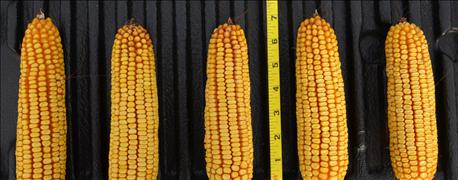
One of the big questions heading into the 2016 corn planting season was whether or not there is a difference between an agronomic best seeding rate and an economic optimum seeding rate. Purdue University’s corn specialist, Bob Nielsen, contends that there is. With even tighter budgets than a year ago and the temptation, if not necessity, to cut costs, some may look at backing off seeding rates. What will happen if you do?

POPULATION EFFECT: Changing population can affect ear size, and changing population may impact ear size in some hybrids more than in other hybrids.
It seemed like such a good question a year ago that Indiana Prairie Farmer worked with the crew at the Throckmorton research center, a Purdue outlying farm, Nielsen and Tippecanoe County Extension ag educator Karen Mitchell to set up a replicated plot on a field-size scale to search for answers. Special thanks goes to Jay Young, Throckmorton’s superintendent; Pete Illingworth, mechanic and farm crew member; and Josh Synesael for helping with the plot. Beck’s, Atlanta, Ind., provided two different hybrids for the study, and also provided manpower to help do stand counts before harvest.
Sneak peek
The data will be analyzed and compared later this winter. Look for the results. They will be available before you need to make final decisions about seeding rates. You won’t want to base your decision on this single study. It’s one piece of a puzzle, representing what happened in one year at one location. However, coupled with trials from other locations and in other years, it may help you draw some conclusions about whether or not you can cut back on seeding rate without expecting to sacrifice yield.
The real question becomes how far you can cut back. A very low seeding rate, 26,000 seeds per acre, was included to test the breaking point at which stands are so thin that modern hybrids sacrifice yields. The highest seeding rate, 38,000, was included to test the theory of whether adding more seed increases yield. And if it does, does it increase it enough to justify the cost of the extra seed?
Teaser
Before planting season arrives, Nielsen will supply data to help answer those questions. Meanwhile, ears pulled for each population and each hybrid, laid side by side, give some indication of what happens when you vary population.
Obviously, Hybrid A on the left reacted differently than Hybrid B on the right. The seeding rates from left to right in each photo were 26,000; 29,000; 32,000; 35,000 and 38,000, respectively. Note that the ears for Hybrid A remain relatively the same length. However, the ears for Hybrid B tend to change in length at higher populations.
Even without the first bit of data, these pictures indicate two things: changing population can affect ear size, and changing population may impact ear size in some hybrids more than in other hybrids.
HYBRID A: These ears (from left to right) came from planted populations of 26,000; 29,000; 32,000; 35,000; and 38,000, respectively. Note ear length of Hybrid A is similar. HYBRID B: Note that as you move from thinner to thicker populations (from left to right), ear length of Hybrid B becomes somewhat shorter.
About the Author(s)
You May Also Like




